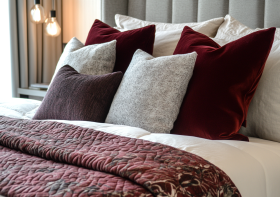A Guide to Combining Prints and Patterns Harmoniously

Mixing patterns in home decor is a bold and creative way to express your personal style and add dynamism to any space. However, without careful consideration, this approach can quickly become overwhelming or clash. By understanding some key principles of design, you can confidently mix patterns to create a visually stimulating environment that feels cohesive and stylish. Here’s a guide to help you master the art of combining prints and patterns in your home decor.
Start with a Color Scheme
The foundation of successful pattern mixing is a cohesive color palette. Choose one or two main colors to anchor your space, and use variations of these hues across different patterns. This creates a harmonious look even when the patterns themselves are diverse. Neutral colors can act as a balancing element, giving the eye a place to rest when multiple patterns are used.

Vary the Scale of Patterns
To avoid visual chaos, mix patterns of different scales. Combine a large bold print with a smaller, subtler pattern. For instance, pair a large floral wallpaper with small geometric pillows or a mid-sized striped rug. This variation keeps the space dynamic without competing patterns that can overpower each other.

Balance with Solids
When you introduce multiple patterns into a room, balance them with solid colors. Solid-colored furniture, curtains, or rugs can help ground the patterns and prevent the room from feeling too busy. These solid elements should complement the colors in your patterns to maintain a cohesive look.

Incorporate Different Types of Patterns
To add depth and interest, mix different types of patterns. For example, florals and stripes or polka dots and plaids can surprisingly go well together. The key is to ensure that there is a common color or theme linking the patterns. You can also consider adding an organic element, like an animal print or leaf pattern, to give the room a fresh and lively feel.

Use Textures as Patterns
Textures can act like patterns without being overtly bold. Mixing textures can add a tactile dimension to your space, enhancing the overall complexity in a subtle way. Think of pairing a smooth, silk throw on a linen sofa or a rough, nubby textile beside a sleek, glossy surface.

Test Your Patterns Together
Before committing to certain pattern combinations, test them in the intended space. You can do this by placing fabric swatches, paint chips, or wallpaper samples together in the room to see how they interact under various lighting conditions throughout the day. This trial will help you feel more confident in your choices before making final decisions.

Distribute Patterns Evenly
To achieve balance, distribute patterns evenly throughout the space. Avoid clustering all patterned elements in one area; instead, spread them out to create a sense of harmony and flow. For example, if you have a patterned rug, consider adding patterned cushions or artwork on the opposite side of the room.

Keep Room Function in Mind
Consider the function of the room when choosing patterns. For instance, a bedroom might benefit from softer, more subdued patterns that promote relaxation, while a living area can handle more vibrant and energetic patterns. This functional consideration ensures that the room not only looks good but also feels appropriate for its purpose.

By following these guidelines, you can confidently mix and match patterns to create a unique and cohesive home decor that is both engaging and harmoniously balanced. Whether you’re redecorating a single room or your entire home, these tips will help you navigate the exciting world of patterns to achieve a truly personalized aesthetic.
To deepen your understanding of crafting unique and personalized spaces, consider acquiring my book, A Guide to Home Design, available on Amazon. This guide offers a comprehensive exploration of various design principles tailored to distinct environments, providing you with the knowledge and inspiration needed to transform any space. If you want to learn more about the colors in Interior design, buy my book Color theory in interior design from Amazon.




